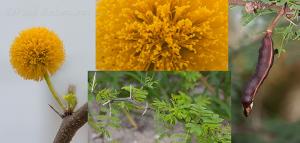
Sweet acacia is a native shrub to small tree of the southern-most band of states from Florida and Georgia west into California. It is closely related to the iconic trees of the African savanna landscapes, including the umbrella thorn acacia.
For a while we had an acacia tree in our yard that after a very slow start had grown from a seedling to about ten feet tall. However it did not survive being relocated to make way for a new septic system.
Until recent reclassifications Acacia was the largest genera in the pea family with about 1500 species worldwide. The greatest number of species – roughly 900 - occur in Australia, and those native to that continent are the ones that retained the genus name Acacia. Most of the Florida natives were moved to the genus Vachellia, including sweet acacia, which changed from Acacia farnesiana to Vachellia farnesiana farnesiana. Many of the African native acacias are now Vachellia or Sengalia.
In Florida sweet acacias are mostly found on shell middens, coastal hammocks, pinelands and disturbed sites, more frequently in the southern peninsula. They are usually eight to 20 feet tall and the many branching trunks can make them six to ten feet wide.
 Sweet Acacia zig-zags and thorns
Sweet Acacia zig-zags and thorns
The zig-zag branches have whitish thorns that are actually spinescent stipules. Stipules are pairs of appendages that are at the base of many leaf stems, but are more frequently very small and leaf-like.
The alternate leaves are bipinnately compound with each leaf divided into two to six pairs of pinnae, each of which has ten to 25 pairs of tiny linear leaflets. This gives the plant an appearance similar to a mimosa and in fact Carl Linnaeus first classified sweet acacia as Mimosa farnesiana in 1753.
Flowers are a globular cluster of yellow stamens 3/8 - 1/2 inch in diameter appearing at the end of not quite inch long stalks.
Acacia is derived from the Greek word akis, meaning a point or barb. Vachellia is named in honor of George Harvey Vachell (1789-1839) who collected plants in China while there serving as a chaplain to the British East India Company. The specific name farnesiana is in honor of Italian Odoardo Farnese (1573–1626) whose family maintained a private botanical garden in Rome and imported these trees from the Caribbean. Sweet acacia was used to make perfume and is still grown in southern France for that purpose.
Sweet acacia is a larval host plant for the Ammon blue (Cyclargus ammon) and nickerbean blue - also known as the acacia blue - (Hemiargus ammon) butterflies, the latter now only known to occur on Big Pine Key. It is also a nectar food plant for red-banded hairstreak (Calycopis cecrops) butterfly.
Paul Rebmann
May 2, 2018